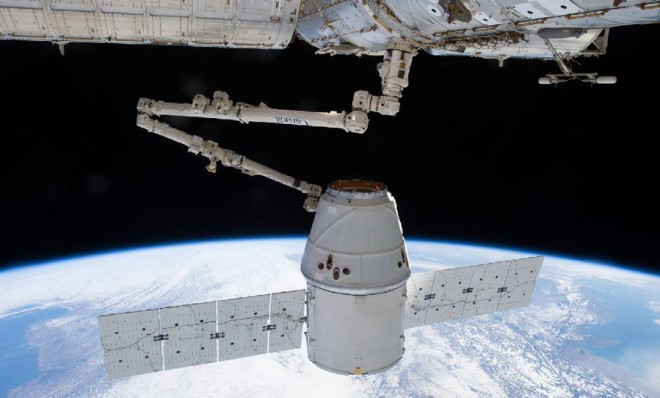Everything you need to know about commercial space travel
It's coming to an orbit near you — and soon

Looking at NASA's shrinking budget and retired shuttle fleet, it's tempting to think that America no longer has the cash to conquer the last great frontier. But in fact, U.S. companies are aggressively and successfully launching into private space travel — with NASA's blessing. The commercial company SpaceX successfully docked a cargo spacecraft on the International Space Station on March 3, and private passengers could be headed to full orbit as early as 2015.
Here's everything you need to know about the future of commercial space travel, with input from an MIT engineering professor, a NASA scientist, and an award-winning science fiction writer.
First off: Is NASA dead or what?
The Week
Escape your echo chamber. Get the facts behind the news, plus analysis from multiple perspectives.

Sign up for The Week's Free Newsletters
From our morning news briefing to a weekly Good News Newsletter, get the best of The Week delivered directly to your inbox.
From our morning news briefing to a weekly Good News Newsletter, get the best of The Week delivered directly to your inbox.
John Karcz, a space scientist at NASA's Ames Research Center in California, certainly doesn't think so. "The private sector has been involved with NASA since the very beginning" he told me. And indeed, NASA has been awarding money to private scientific space missions through its Discovery Program since 1992. In 2009, it began soliciting proposals from private companies interested in sending humans into orbit. A year later, President Obama announced that private development was crucial to U.S. advancement in space. As Larry Bell at Forbes puts it, if companies can start providing services to NASA at lower costs, "NASA can turn its full attention to doing things that they are very good at… like planning future robotic and human planetary exploration missions."
When will commercial space travel be a reality?
Soon. Start by watching this SpaceX promotional video (complete with cheesy action movie music) to get pumped:

"Suborbital" space travel is already here: By the end of 2013, Virgin Galactic will start charging tourists around $200,000 to fly straight up into the atmosphere and spend a few minutes in actual space. (Katy Perry, Tom Hanks, and Brangelina have already signed up.) MIT Professor Ed Crawley says this kind of travel takes only about "1/100th of the energy of going all the way into orbit." He predicts that in five years, the "commercial suborbital market will be robust, with hundreds of people traveling to space a year, not much more than the number that try to climb Everest every year, at a similar price and perhaps more safely."
A free daily email with the biggest news stories of the day – and the best features from TheWeek.com
Going into orbit is the real deal; that's where a spacecraft gets high enough to actually circle Earth. SpaceX, Boeing, and the Sierra Nevada Corporation all have contracts with NASA to develop orbital human spaceflight for both commercial and government customers, and Karcz says there are other unfunded companies working on private orbital travel, too. SpaceX is reportedly planning to launch its first human passengers into orbit by 2015, although SpaceX manager and ex-NASA astronaut Garrett Resiman joked at a press conference that they're not taking any tourist applications yet, so "don't call our toll-free number."
Ultimately, commercial companies will take passengers to both the International Space Station and private space stations, like the inflatable ones being developed by Bigelow Aerospace. According to the Mercury News, a month-long trip to a private Bigelow space station would set you back about $25 million. Here's what those space stations could look like (I didn't pick the music for this, seriously):

So is this only for rich people?
Yeah, space tourism is only for rich people. But there are scientific benefits of these missions, too. For instance, NASA is supporting companies that develop cargo spacecraft to bring items like water, food, clean clothes, computers, and spare parts to the International Space Station. This will save taxpayers money.
And there are plenty of other ways that private space advancements could benefit us all: A company called Planetary Resources, formed in 2010, is working to expand technology in asteroid mining (according to the company's website, there are over 1,500 asteroids as easy to get to as the moon.) David Brin, Ph.D., a scientist and science-fiction author who has won Hugo and Nebula Awards, theorizes that this company could harvest water, "which costs a fortune to lift from Earth...[and] later, there is a high likelihood of acquiring many of the rare elements that are today torn out of Earth and refined through toxic processes, but could instead be brought home cleanly from space."
Commercial space companies are also reportedly planning to launch small, low-orbit satellites to map and assist with agricultural development. (The European Space Agency and the UN Fund for Agricultural Development have already partnered to track some of the most rural areas on Earth, and identify things like long-term trends in Vietnamese rice cultivation.) Of course, not everyone sees private surveillance as a good thing: "The flood of cameras filling our streets could empower some Big Brother state or corporate oligarchy," warns Brin. "It is always wise to beware of possible downsides."
What are the downsides?
Commercial space development hasn't gone perfectly: During SpaceX's third unmanned launch, it had a "serious propulsion malfunction that threatened to cripple their capsule," according to The Wall Street Journal. The independent Aerospace Safety Advisory Panel has also expressed concerns about letting commercial space flight get too big without NASA oversight: "Separating the level of safety demanded in the system from the unique and hard-earned knowledge that NASA possesses introduces new risks and unique challenges to the normal precepts of public safety and mission responsibility" the panel wrote in a report. However, Crawley insists that "we should let commercial companies do what they can, provided it is safe," and says that airplanes are already extremely safe because of the efforts of the Federal Aviation Administration. "This is a model that will evolve for space flight too."
Other groups have questioned the environmental impact of commercial space travel. A report funded by NASA and the private Aerospace Corporation predicts that an increase in the number of sub-orbital rockets could lead to higher levels of pollution, exacerbating global warming. (Virgin Galactic flatly denies the report's conclusions.)
But in the end, Brin says, we are "a vibrant, curious people," and we shouldn't "become so obsessed with the downsides that we ignore [what] technology can do for us.
One other downside: Space warfare.
Dana Liebelson is a reporter for Mother Jones. A graduate of George Washington University, she has worked for a variety of advocacy organizations in the District, including the Project on Government Oversight, International Center for Journalists, Rethink Media, the Reporters Committee for Freedom of the Press, and Change.org. She speaks Mandarin and German and plays violin in the D.C.-based Indie rock band Bellflur.
-
 Hilarious comedians to see on tour this winter
Hilarious comedians to see on tour this winterThe Week Recommends Get some laughs from Nate Bargatze, Josh Johnson and more
-
 A January deadline could bring the pain all over again
A January deadline could bring the pain all over againToday’s Big Question A January deadline could bring the pain all over again
-
 Political cartoons for December 23
Political cartoons for December 23Cartoons Tuesday's political cartoons include an eye on CBS, cracking the middle class, and Donald Trump's name on everything